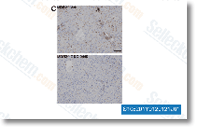RT qPCR RNA extraction and quantitative PCR had been performed as described by Tao et al. The primers that had been employed for quantitative PCR are listed in Extra file 15. Promoter efficiency evaluation The promoters of HSF1, SFA1, and ALD6 from BYZ1 had been cloned into Sac I and Xho I web pages before the Cre gene of plasmid pSH47. Inverse PCR was utilised to introduce the sequence mutations of YJS329 shown in Figure 4. The efficiency of the promoters selleck was evaluated through the ex pression exercise in the report gene Cre. The values had been represented by the log2 ratio of YJS329/ BYZ1. The primers that had been utilised for promoter cloning and RT qPCR are listed in More file 15. Genetic manipulation The total length HSF1 ORF along with 807 bp in the se quence upstream in the ORF was cloned into the CEN6 plasmid, pGFP ble. Deletion in the two copies of FPS1 in YJS329 was carried out as previously described.
In all scenarios, homozygous gene deletions were confirmed by diagnostic PCR. Overexpression of ALD6 was carried out by cloning the ALD6 ORF plus one,005 bp of upstream sequence and 407 bp of down stream sequence into plasmid pYZ, and that is derived from pYES2 but with bler changing the URA3 marker. Background Laurencia dendroidea is really a red seaweed species wide selleckchem spread inside the Atlantic Ocean, whose kind locality is in Brazil. It can be noticed through the intertidal for the subtidal zone at 3m depth. The thalli are erect, forming dense tufts 4 20 cm large, brown purple or violet greenish in color. The genus Laurencia was recognized, since the 1st studies on organic solutions during the 1960s, as an essential supply of secondary metabo lites, largely halogenated compounds. The secondary metabolites of Laurencia play a pertinent ecological function as chemical defenses towards bacterial colonization and infection.
Seaweeds are especially prone to microbial colonization due to the biosynthesis and release of huge amounts of natural compounds, which might serve as chemo attractants and nutrient supply for microbes. Within this context, secondary metabolites and exudates may possibly act collectively deciding on  the microbial local community asso ciated with the surfaces and tissues of seaweeds. Host microbe interaction is extensively acknowledged as a single of your primary driving forces for co evolution in the marine setting, resulting in the establishment of helpful microbiomes. As an example, microbes linked with seaweed tissues may possess the skill to fix nitrogen, mineralize the organic substrates as well as supply the seaweeds with carbon dioxide and growth factors. The microbiome on seaweeds tends to become species certain and distinctive from the surrounding seawater. How ever, the characterization from the microbial neighborhood li ving in the surface of macroalgae is still limited plus the molecular studies of those communities are unusual.
the microbial local community asso ciated with the surfaces and tissues of seaweeds. Host microbe interaction is extensively acknowledged as a single of your primary driving forces for co evolution in the marine setting, resulting in the establishment of helpful microbiomes. As an example, microbes linked with seaweed tissues may possess the skill to fix nitrogen, mineralize the organic substrates as well as supply the seaweeds with carbon dioxide and growth factors. The microbiome on seaweeds tends to become species certain and distinctive from the surrounding seawater. How ever, the characterization from the microbial neighborhood li ving in the surface of macroalgae is still limited plus the molecular studies of those communities are unusual.
DNA metabolism
Siteman Cancer Center's DNA Metabolism and Repair Program includes 23 investigators
